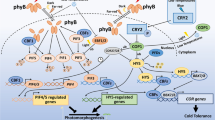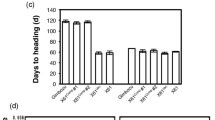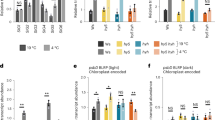Summary
Dark-grown pea seedlings exposed to cyclic heat shocks or daily temperature changes undergo a morphogenetic development similar to that induced by far red light. The morphological changes observed include expansion of the leaves, shortening of the stems and opening of the hooks. Compared with control etioplasts, plastids of heat-treated seedlings are as large as fully mature chloroplasts and contain well developed, unstacked membranes. These morphogenetic changes correlate with elevated levels of SSU and LHCP mRNAs which, under these conditions, fluctuate in a circadian manner. In contrast, the ELIP mRNA remains under strict light control and shows circadian fluctuations only if the plants are exposed to a short period of illumination. We propose that periodic temperature changes, like light treatment, might serve as a ‘Zeitgeber’ signal for circadian rhythm. The data indicate a correlation between the existence of circadian oscillations and morphogenetic development.
Similar content being viewed by others
Abbreviations
- CAB:
-
gene(s) coding for chlorophyll a/b binding protein
- ELIP:
-
early light-inducible protein
- LHCP:
-
chlorophyll a/b binding proteins
- SSU:
-
small subunit of ribulose-1,5-bisphosphate carboxylase (ssRuBPCase)
References
Apel K (1979) Phytochrome-induced appearance of mRNA activity for the apoprotein of the light-harvesting chlorophyll a/b protein of barley (Hordeum vulgare) Eur J Biochem 97:183–188
Bennett J (1981) Biosynthesis of the light-harvesting chlorophyll a/b protein. Polypeptide turnover in darkness. Eur J Biochem 118:61–70
Banning E (1979) Circadian rhythms, light, and photoperiodism — A re-evaluation. Bet Mag 92:89–103
Cashmore T (1991) VI. Nato Advanced Study Institute, in press
Chory J, Peto C, Feinbaum R, Pratt L, Ausubel F (1989) Arabidopsis thaliana mutant that develops as a light-grown plant in the absence of light. Cell 58:991–999
Evans LT (1969) The induction of flowering. MacMillan, Melbourne
Fromm H, Devic M, Fluhr R, Edelman M (1985) Control of psbA gene expression in mature Spirodela chloroplast light regulation of 32-kd protein synthesis is independent of transcript level. EMBO J 4:291–295
Giuliano G, Hoffman NE, Ko K, Scolnik P, Cashmore AR (1988) A light-entrained circadian clock controls transcription of several plant genes. EMBO J 7:3635–3642
Grimm B, Kloppstech K (1987) The early light inducible proteins of barley: characterization of two families of 2 h specific nuclear coded chloroplast proteins. Eur J Biochem 167:493–499
Hoober JK, Marks DB, Keller BJ, Margulies MM (1982) Regulation of accumulation of the major thylakoid polypeptides in Chlamydomonas reinhardth. J Cell Biol 95:552–558
Kloppstech K (1985) Diurnal and circadian rhythmicity in the expression of light-induced plant nuclear messenger RNAs. Planta 165:502–506
Kloppstech K, Meyer G, Bartsch K, Hundrieser J, Link G (1984) Control of gene expression during the early phase of chloroplast development. In: Wiessner W, Robinson DG, Starr RC (eds) Compartments in algal cells and their interaction. Springer, New York, pp 36–46
Kloppstech K, Meyer G, Schuster G, Ohad I (1985) Synthesis, transport and localization of a nuclear coded 22-kd heat shock protein in the chloroplast membranes of peas and Chlamydomonas reinhardi. EMBO J 4:1901–1909
Logemann J, Schell J, Willmitzer L (1987) Improved method for the isolation of RNA from plant tissues. Anal Biochem 163:1620
Meyer G, Kloppstech K (1984) A rapidly light-induced chloroplast protein with a high turnover coded for by pea nuclear DNA. Eur J Biochem 138:201–207
Mohr H (1972) Photomorphogenesis. Springer,Berlin Heidelberg New York
Mohr H (1984) Phytochrome and chloroplast development. In: Baker NR, Barber J (eds) Chloroplast biogenesis. Elsevier, Amsterdam, pp 305–347
Mosinger E, Batschauer A, Vierstra R, Apel K, Schäfer E (1987) Comparison of the effects of exogenous native phytochrome and in vivo irradiation on in vitro transcription in isolated nuclei from barley (Hordeum vulgare) Planta 170:505–514
Mullet JE (1988) Chloroplast development and gene expression. Annu Rev Plant Physiol 39:475–502
Nagy F (1991) VI. Nato Advanced Study Institute, in press
Nagy F, Kay SA, Chua NH (1988) A circadian clock regulates transcription of the wheat cab-1 gene. Genes Dev 2:376–382
Neville OM (1971) Molecular weight determination of protein-dodecylsulfate complexes by gel electrophoresis in a discontinuous buffer system. J Biol Chem 241:6328–6334
Otto B, Grimm B, Ottersbach P, Kloppstech K (1988) Circadian control of the accumulation of mRNAs for light- and heatinducible chloroplast proteins in pea (Pisum sativum). Plant Physiol 88:21–25
Paulsen H, Bogorad L (1988) Diurnal and circadian rhythms in the accumulation and synthesis of mRNA for the light-harvesting chlorophyll a/b binding protein in tobacco. Plant Physiol 88:1104–1109
Piechulla B, Gruissem W (1987) Diurnal mRNA fluctuations of nuclear and plastid genes by developing tomato friuts. EMBO J 6:3593–3599
Rigby RW, Dieckmann M, Rhodes C. Berg P (1977) Labeling deoxyribonucleic acid to high specific activity in vitro by nick translation with DNA polymerase. J Mol Biol 113:237–251
Silverthorne J, Tobin EM (1984) Demonstration of transcriptional regulation of specific genes by phytochrome action. Proc Natl Acad Sci USA 81:1112–1116
Spiller SC, Kaufman LS, Thompson WE, Briggs WR (1987) Specific mRNA and rRNA levels in greening pea during recovery from iron stress. Plant Physiol 84:409–414
Spurr AR (1969) A low viscosity resin-embedding medium for electron microscopy. J Ultrastruct Res 26:31–43
Stern K, Banning E (1929) Über die tagesperiodischen Bewegungen der Primärblätter von Phaseolus multiflorus. I Der Einfluβ der Temperatur auf die Bewegungen. Ber Dtsch Bet Ges 47:565–584
Tavladoraki P, Kloppstech K, Argyroudi-Akoyunoglou J (1989) Circadian rhythm in the expression of the mRNA coding for the apoprotein of the light-harvesting complex of photosystem II. Plant Physiol 90:665–672
Tobin EM (1981) Phytochrome-mediated regulation of messenger RNAs for the small subunit of ribulose-1,5-bisphosphate carboxylase and the light harvesting chlorophyll a/b protein in Lemna gibba. Plant Mot Biol 1:35–51
Tobin EM, Silverthorne J (1985) Light regulation of gene expression in higher plants. Annu Rev Plant Physiol 6:569–593
Author information
Authors and Affiliations
Additional information
Communicated by R.G. Herrmann
Rights and permissions
About this article
Cite this article
Kloppstech, K., Otto, B. & Sierralta, W. Cyclic temperature treatments of dark-grown pea seedlings induce a rise in specific transcript levels of light-regulated genes related to photomorphogenesis. Molec. Gen. Genet. 225, 468–473 (1991). https://doi.org/10.1007/BF00261689
Received:
Issue Date:
DOI: https://doi.org/10.1007/BF00261689




